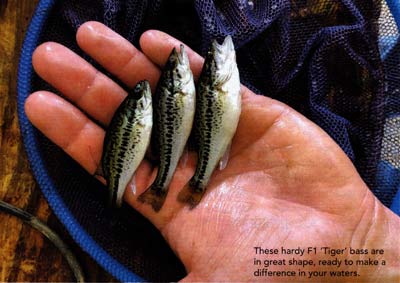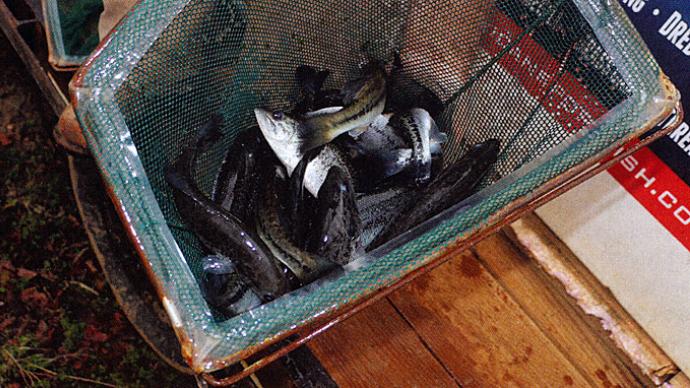
A common question to fisheries biologists is about the effectiveness of supplemental stocking of bass to enhance the genetics of an existing fishery.
Texas Parks and Wildlife's "Sharelunker" program is the most glaring evidence of that practice. The state agency started that program years ago. During the spawning window in late winter or early spring, if an angler catches a bass bigger than 13 pounds, it can be loaned to the state fish hatchery in Athens, Texas. There, they nurture the fish, identify it (yes, they can look at its genes and see if that fish came from parents identified years ago), and quantify its genetics. If that fish fits the qualifications, they'll set the stage for it to spawn. Then, they take the babies, grow them in hatchery ponds, and stock public lakes with these superior-genetic fingerlings.
That program has paid huge dividends for the state over the years. Today, more and more lakes are producing truly trophy bass and has created something more than a cottage industry around the most productive lakes during spawning season. Think hotel rooms, restaurants, and lure companies.
Many lakes have seen measured improvement in bass sizes due to this program.
Can you do the same with your lake?
Yes...as long as you understand the exercise.
Uh, what does that mean?
I interviewed several nationally known private sector fisheries experts to ask their opinions. The first conversation was with Dr. Shawn McNulty, an American Sport Fish Hatchery owner outside Montgomery, Alabama. (For transparency, they bought my pond management company in 2019). Shawn is responsible for producing the trademarked F1 "Tiger" bass at American Sport Fish. He said, "When someone stocks F1 bass, those are an intergrade cross between our hand-selected, genetically superior Florida and Northern Strain bass. That first cross is the F1. That first generation has the genetics for hybrid vigor, the best of both parents. But when those fish grow up and begin to reproduce, they can't produce any F1 babies, so a pond ends up with F2s or Fxs. Either way, babies from F1's can't be what their parents are".
It seems complicated, but it's not. When a rancher crosses a red Hereford with a black Angus, they get a "Black Baldy." That's a black calf with a white face. But when those black baldies cross with each other, what do their babies look like? Exactly. Same concept with F1 bass.
Shawn is a big believer in stocking more F1's in existing lakes every three or four years. He recommends stocking 50 bass fingerlings per acre to supplement existing genetic stocks. He said, "We can have our baby bass ready before most pond's natural spawns grow so large, so we can often get ahead of those spawns."
I spoke with Greg Grimes, a Ball Ground, Georgia, fisheries biologist. He agrees with the theory, although he's not followed the practice. "If I want to enhance the gene pool, I typically stock some larger Florida bass if we can find them. (Heavy on the word 'find') That helps ensure survival rates so they can spawn with existing fish."
Digging deeper into the theory, Grimes said, "Stocking 50 fingerling bass per acre is hard to track. We can't track the results without doing some genetic studies, and landowners are generally hesitant to track genetic results. In their minds, they wonder why they should invest several hundred dollars in genetic testing when they can just spend that money on those bass. The desire is there, but the dollars don't work".
Grimes continued, "In established lakes, we prefer to use F1 or pure strain Florida bass at least 8 inches long to help ensure survival". If the goal is to improve genetics, Grimes prefers the purer strain to the F1's.
Dr. Jeff Slipke, fisheries biologist with Midwest Lake Management Company in northwest Missouri, has a similar mindset. "There's no doubt that stocking enhanced genetics works in the right conditions. We've got clients nationwide where we've added better genetics and seen the results." He said, "Stocking 50 small fingerling bass per acre into an existing bass lake makes sense, especially if we know existing genetics need improvement".
There's a story of an existing lake, fifty-plus years old that hadn't grown a bass bigger than six pounds in years. That landowner didn't want to start over but was open to culling existing bass, rebuilding the food chain, and adding some F1 "Tiger" bass.
Four years later, he was catching bass bigger than he'd seen in years.
One big hang-up about stocking fingerling bass into existing lakes is survival rates. I asked all three, "What do you think survival rates are?" To the man, each one said, "There's no way to know." But, doing some math, let's say 95% of the little darlings you just spent $1.50 each get eaten by those mean predators in your lake. If that's the case, you still get 5 out of a hundred that make it to adulthood. Those fish are added to the population, influencing with their genetics...and might be the next double-digit fish.
McNulty made another excellent point. "If people are culling heavily, studies have shown the most aggressive bass are often being harvested. Adding some bass from time to time helps mitigate that paradigm."
A story from The Roanoke Times, in Virginia, in March 2022, talks about Smith Mountain Lake and the results of stocking F1's into those public waters. They've been stocking F1's since 2015, adding 20,000-70,000 yearly. Now, anglers are reporting bass over 8 pounds, with more significant numbers attaining greater weights. A state biologist is quoted in the article saying that they are also seeing growth of the Largemouth bass population, motivating them to keep funding the project. When sampling, they also found that greater percentages of their catches, at least 4 pounds or larger, are the F1 bass. The article states that in 2019,2% of bass larger than 4 pounds were Tiger bass. 2020, that number grew to 10%, and in 2021, it was 13%.
Each private-sector biologist has a bit of trepidation about the survival rates of stocking small bass into existing private lakes simply because we can't scientifically prove the results. When it boils down to it, each one agreed it's a good practice. Adding 50 fingerling bass per acre to enhance genetics, mitigate harvest of aggressive bass, and improve bass recruitment with better odds of growing larger bass is worth the $75 per acre a pondmeister might spend every few years for unmeasurable results.
Heck, if you're like most of us, we'll spend that much at least one Friday night per month on a night out to eat. You might as well throw some of those dollars into the lake, right?


